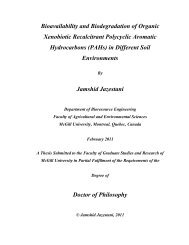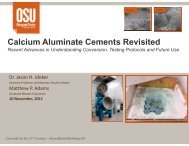i THERMAL PROCESSING EFFECTS ON TOTAL ... - McGill University
i THERMAL PROCESSING EFFECTS ON TOTAL ... - McGill University
i THERMAL PROCESSING EFFECTS ON TOTAL ... - McGill University
Create successful ePaper yourself
Turn your PDF publications into a flip-book with our unique Google optimized e-Paper software.
include compounds such as phytate, polyphenols, enzyme inhibitors (trypsin,<br />
chymotrypsin, and α-amylase) and haemagglutinins. Reduction of these anti-nutrients<br />
was significantly greater when these legumes cooked by autoclave at 121º C or 128ºC,<br />
compared to other traditional processes (ur-Rehman and Shah, 2005). Additionally, when<br />
various lentil cultivars‘ flour was digested with pepsin and pancreatin, the in-vitro protein<br />
digestibility was reduced from 77.1%-88.0% by the process of normal cooking (Sulieman,<br />
Mashair, 2008).<br />
Phytic acid is considered an antinutritional compound given its ability to bind<br />
essential dietary minerals as well as proteins and starch, and to consequently reduce their<br />
bioavailability in humans (Philippi, 2003). The toxic effects of lectins are due to their<br />
ability to bind to specific receptor sites on the surface of intestinal epithelial cells, which<br />
causes an interference with the absorption of nutrients across the intestinal wall. Bound<br />
lectins also impair the transfer of amino acids, leading to a decrease in protein<br />
digestibility (Adsule et al., 1989).<br />
2.5.2 Effects of thermal processing on protein digestibility<br />
Cooking, soaking, roasting, boiling, germination and other conventional cooking<br />
methods are applied to lentils in order to inactivate the antinutritional compounds and to<br />
improve of protein digestibility.<br />
Monsoon and Yusuf, (2002), found that non-soaked lentil seeds after dry heating<br />
or autoclave treatments which caused reduction in trypsin inhibitor activity, tannins and<br />
phytic acid and increased tannin/catechins ratio without causing any significant changes<br />
in in-vitro protein digestibility of lentils. On the other hand, soaking of lentil seeds<br />
followed by traditional or autoclave cooking process, has been found to significant by<br />
decrease phytic acid and tannin content, and improve in-vitro and in-vivo protein<br />
digestibility (Savage and Scott, 1989; Zia-ur-Rehman and Shah, 2005). Paraná et al.,<br />
(2000) reported that microwave treatment caused a significant reduction in trypsin<br />
inhibitor activity and hæmaglutinins of raw and soaked lentils. All the above forms of<br />
20









